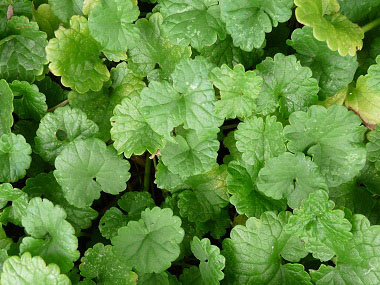5. Creeping Charlie

Also called Ground Ivy and technically called Glechoma hederacea, this weed grows in many places and can take over once it starts growing. Though it is in the mint family, it does not smell or taste minty. Though pregnant and nursing women should avoid this plant, it does have many uses, but is most often used for headaches and colds and consumed as a tea.
6. Lamb’s Quarters

I pulled these “weeds” for months when I found them in our yard before I realized that they are edible and a highly-nutritious green!
The leaves of Lamb’s Quarters can be used like spinach in fresh dishes or in cooking, but they are easier to grow and many people find them tastier. They are naturally high in Vitamin K, Vitamin A, Calcium and Mangesium. In fact, Lamb’s Quarters are considered one of the most nutritive wild foods, second only to Amaranth.
Important: Lamb’s Quarter has a poisonous lookalike called Nettleleaf Goosefoot that should never be consumed. There is a definite difference in their look and Nettleleaf Goosefoot has a terrible odor, but it is important not to ever confuse the two (this post has a side by side comparison and other good info). Like spinach and many other greens, Lamb’s Quarters is high in oxalic acid and should be consumed in moderation, especially by those with conditions aggravated by oxalic acid. Cooking reduces much of it and make this and other greens safer to consume.
7. Stinging Nettles

If you have Nettle growing in your yard, you probably know about it, since they tend to leave a painful and itchy rash if you touch them with bare hands. Fortunately, the tiny acid-filled needles that cause the stinging fall off when cooked or boiled and the remaining leaves are highly nutritious and often recommended for their benefits.
I add nettle to my pregnancy tea for its high content of vitamins and minerals, and it is beneficial in many other ways as well (from MRH):
Nettle’s purported anti-inflammatory effects have been repeatedly confirmed by modern research over the past ten years. It is particularly effective in treating allergic rhinitis, relieving nearly all the symptoms of itchy, watery eyes, sneezing and runny nose. It also has performed better than the prescription drug furosemide in reducing blood pressure, increasing urine output as a diuretic and increasing salt excretion. It also seems to be effective in reducing pain and producing a sedative effect. It is important to keep in mind that the medicinal effects of the leaf and root of the nettle are markedly different. Nettle root, for instance, shows exceptional efficacy in treating prostate complaints in men. Nettle leaf has some of the same effects, but not to the same extent. The leaf, on the other hand, shows some promise in boosting immune system function and is an effective treatment for many skin conditions. One final use should be noted and that is nettle leaf has been used as a hair and scalp treatment for centuries, and again, those uses are being supported by research as well. Nettle leaf extract seems to promote hair regrowth and thicken hair, as well as reducing dandruff and scalp conditions when used as a rinse.
Nettle tea is sometimes used as a short term remedy for allergies, and nettle is also considered wonderful for encouraging hair growth… In fact I use nettle leaf in my hair growth serum for thicker and stronger hair.
If you decide to harvest your own nettle leaf, make sure to wear gloves and transfer the leaves into a bag until they can be boiled, avoiding contact with skin until after they are cooked. You can even make nettle chips from the leaves (similar to kale chips) if you get brave.
Share This Post














